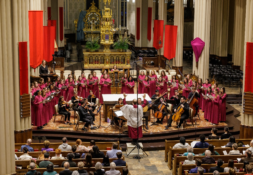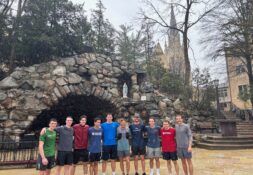Famed art historian gives keynote lecture at Fall Conference
Author, lecturer, professor of art history at the Pontifical University of St. Thomas Aquinas and Duquesne University’s Italian campus, and certified sommelier Dr. Elizabeth Lev gave the closing keynote lecture at the de Nicola Center for Ethics and Culture’s annual Fall Conference. Her lecture, entitled Creation, Complementarity, and Saint John Paul II in Michelangelo’s Sistine Ceiling, related Michelangelo’s famous paintings to the theme of the Conference, “And It Was Very Good.”
After an introduction by Center Director O. Carter Snead, Dr. Lev retold the story of the Sistine Chapel, beginning with the commission that a young Michelangelo Buonarotti received from Pope Julius II to paint the ceiling of the Chapel in 1508. Lev then followed this story with that of the cleaning and restoration of the Chapel’s ceiling in 1981 by Pope John Paul II. These two momentous Papal endeavors—the creation and the restoration—allowed beholders both modern and renaissance to “gaze upon the shining beauty, truth and goodness that the chapel proclaimed”—that of the theology of the body.
The project with which Michelangelo was tasked was relatively small, Lev explained. Lured to Rome with the prospect of sculpting a grand mausoleum, he was instead asked to paint the 12 Apostles on the Sistine ceiling, an idea that was promptly rejected by the already-famed artist. Lev noted, “The spirit of artistic adventure led the artist to experiment with a completely new vision of creation. He took a book that had been painted, sculpted, mosaiced, and illuminated over and over again in the history of art and created something completely new … So, he must have been uniquely attuned to the creative power of God the Father as he painted.”
Lev described Michelangelo’s sculptural vision for the frescoed Sistine ceiling: “He rerouted all of that creative thinking that had gone into the tomb project into the ceiling. The pseudo marble architectural framework, the niches and the fictive sculptures that fill them—even casting a shadow in some areas—illustrate the mind of a sculptor-architect bending the art of painting to his vision … Michelangelo’s plan for a sculptural architectural monument in which the medium just happened to be paint stunned the world with its innovation.”
The core of Lev’s address, however, centered around the nine panels that retell the story of the first chapters of Genesis, beginning with God the Father in His first act of creation—separating the darkness from the light.
Lev said, “Daring to show God embodied, [Michelangelo] filled the first three panels with the mighty dynamic figure of the Father at work. In the opening scene … we see God captured by Michelangelo’s brush after He has already started the process of bringing forth existence. He spirals in a very compressed space, and it conveys this sense of kinetic energy.”
The most famous of the Sistine panels, that of the creation of man, shows Adam in the moment before he receives that Divine spark of life. While God is outstretched to man, it is not an image of a lazy or purely passive Adam. This famous panel shows Adam in a state of potentiality, akin to “a runner at the starting block.”
“The beauty of this gesture is that it seems more like an invitation than an order,” Lev continued, “While the sun and moon are commanded with an imperious figure, the gesture of God here is much, much gentler, almost using magnetism to lift the finger of the first man to raise him up.”
It is in this panel, too, where Lev finds evidence of God’s plan to redeem humanity. At the moment of Adam’s creation, God’s arm cradles a woman who is standing above the figure of the Christ child. This woman, explained Lev, is best interpreted as both Mary the Mother of God and as Eve: “This figure shines the brightest when it becomes a conflation of the two great mothers of the Old Testament and the New, the Eve and the new Eve. Even as God creates man, He is preparing for man’s fall and eventual salvation.”
The lynchpin of the ceiling, though, is the creation of Eve, wherein the first woman “stretches across the space as God did in the previous images of creation. Her body still emerging from Adam’s side … makes a link directly to God. With her hands clasped in prayer, she is already an image of the Church—who will be personified by Mary—and the physical connection between God and man in the incarnation.”
Across the ceiling, men and women are always pictured together. From paradise to banishment, Adam and Eve appear together, complimenting and completing the other. It is this fact that led St. John Paul II to remark, “The Sistine Chapel is precisely, if one may say so, the sanctuary of the theology of the human body.”
In his depiction of the Fall, Michelangelo chose not to show a loss of earthly paradise. Rather, he “illustrated what sin wrought on the human person and on his relationships, [yet] the complementarity between men and women remained.”
Reflecting on the keynote address, senior and de Nicola Center for Ethics and Culture Sorin Fellow Ana Reyes told the Rover, “I had never heard of Michelangelo spoken of as such a theologian or so interested in the biblical creation narrative. I had the knowledge that he was a master of his craft and skilled in both painting and sculpting but was surprised and impressed to learn of the depth of spiritual meaning in his work.”
She continued, “By the very nature of beauty, truth, and goodness going together I think that beautiful art can be an effective tool for evangelization. My understanding of just how effective a tool it can be was certainly enhanced and shaped by this presentation.”
Annaliese Anderson, sophomore and Sorin Fellow said of the talk, “Several of my friends and acquaintances told me about [Liz Lev’s] gift for blending intelligence, wit, and profound insight into her captivating stories about art. I must say that she did indeed live up to her reputation. … The talk was invaluable for my understanding of Michelangelo.”
Anderson continued, “I was lucky enough to visit the Sistine Chapel this summer, but, since I am visually impiared, I could not really appreciate his work. I remember being underwhelmed as I squinted up at the ceiling, striving to see any detail of the masterpiece I knew was above me but only being rewarded with distant colors and blurry outlines of shapes. However, Liz Lev through her talk helped me to finally see Michelangelo’s great work. … I was totally engrossed in her presentation and gained so much insight into the genius of Michelangelo—a genius which previously I had been unable to fully absorb.”
Sophomore and Sorin Fellow Luke Dardis reflected on his experience of the lecture, telling the Rover, “Liz gave me a tour of Rome when I visited for my uncle’s ordination back in 2012 … Her ability to capture the dramatic narrative which contextualizes the art of Western civilization is unparalleled, so I was very excited to hear from her again. I found her presentation a refreshing, insightful walk through the panels of the Sistine Chapel.”
Dardis continued, “I was surprised to find how Michelangelo connected his art to the Catholic faith. I’ve studied theology of the body before, and I’ve often reflected on the Sistine Chapel, but Liz demonstrated the intimate relationship between the two. If art is evangelization, Liz is certainly its greatest evangelist! She captured how Michelangelo masterfully [uses] his skills to teach the deepest truths of our faith.”
Her lecture concluded the 22nd Annual de Nicola Center for Ethics and Culture Fall Conference.
Elizabeth Hale is a sophomore from Northville, MI studying political science. While she still struggles to draw stick figures, she enjoys critiquing other artists’ work. To hear her opinion on modern art, email her at ehale@hcc-nd.edu.





